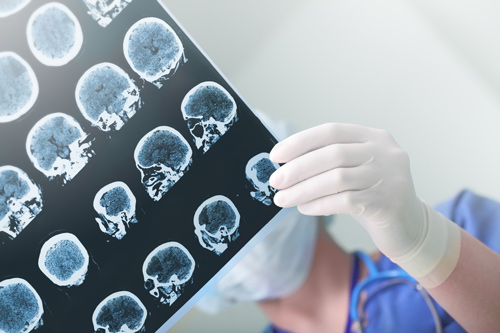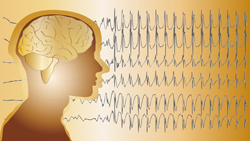
Epilepsy is a neurological disorder that affects the brain by suddenly and briefly changing how it works. Epilepsy shows itself in the form of seizures, which may present in any number of ways, but are characterized as a change in electrical conduction in the brain.
Seizures can be triggered by any number of factors from emotional states, to illness, to external stimulus. While there are some varieties of pseudoseizures that are not associated with epilepsy, all types of epileptic seizures are related by their sudden electrical dysfunction in the brain.
Myths and Facts
 Is epilepsy a disease or disorder? Epilepsy is a neurological disorder with a number of factors, including genetics, brain injury, or illness.(1) In up to 60% of cases, its cause is unknown.(2) Epilepsy is not a disease and cannot be transmitted from one person to another.
Is epilepsy a disease or disorder? Epilepsy is a neurological disorder with a number of factors, including genetics, brain injury, or illness.(1) In up to 60% of cases, its cause is unknown.(2) Epilepsy is not a disease and cannot be transmitted from one person to another.
Are people with epilepsy disabled? There are many different types of epilepsy that present in unique ways. People with epilepsy are just as diverse in their talents and abilities as anyone else. While some are able to work with their condition, others may not be able to.
Do people grow out of epilepsy? Some children with epilepsy do “grow out” of their disorder as they mature, and will not experience any seizures as an adult. Approximately 50% of young patients won’t have seizures as adults.(2)
Types of Seizures(3)
While some seizures present as a generalized tonic-clonic seizure, with reduced consciousness and muscle jerks and rigidity, there are other types that epileptic people may experience:
- Absence (Petit Mal) seizures: characterized by a blank stare and absence, with fully regained consciousness shortly after.
- Simple partial seizures: characterized by isolated jerking or disorientation of one body part or sense.
- Complex partial seizures: characterized by a recurring set of actions.
- Atonic seizures: characterized by brief collapse and complete unresponsiveness, with quick recovery.
- Myoclonic seizures: characterized by sudden and massive muscle jerks that may be confused for clumsiness.
- Infantile spasms: characterized by sudden, quick movements in children ages 3 months to two years.
Many of these other types of seizures do not require immediate first aid like convulsive seizures do, but can still benefit from medical attention for diagnosis and treatment.
Seizure First Aid
Being prepared with this knowledge can help prevent injuries and keep everyone safe and healthy in the event of a convulsive seizure.
“Don’ts” of Seizure First Aid
Some common myths are dangerous misinformation. Putting something in someone’s mouth as they seize or holding their tongue can cause more harm than good. It is impossible for someone to swallow their own tongue, and forcing anything into someone’s mouth can damage teeth or even cause a choking hazard.
Do not try to do anything to wake up or restrain the person seizing. They are experiencing a brief moment of electrical miscondiction in their brain and will not be awoken by shaking or water, and may even be hurt by being restrained.
“Do’s” of Seizure First Aid
If someone is seizing, it is important to look out for their safety. Try to protect their head and ensure that they do not hurt themselves while seizing. Try to time the seizure whenever possible.
Be informed about when a seizure is an emergency or not. For instances with multiple, consecutive seizures, single seizures lasting longer than 5 minutes, pregnant or diabetic people experiencing a seizure, or those injured during or before their seizure, an ambulance should be called. If in doubt, it is always good to air on the side of caution and call for help.
After the seizure, someone could be very disoriented and require further help. Once the seizing has stopped, try to roll the person into the recovery position for safety.
With more people informed about the complexities of seizure disorders, we can make everyday life safer for those affected by epilepsy.
Helpful Resources:
Resources:
“First Aid – Epilepsy Canada.” http://www.epilepsy.ca/uploads/7/0/8/6/70868839/epilepsy_first_aid2011.pdf.
“Answers to Your Questions – Epilepsy Canada.” http://www.epilepsy.ca/uploads/7/0/8/6/70868839/epilepsy_answers2011.pdf
“Children and Epilepsy – Epilepsy Canada.” http://www.epilepsy.ca/uploads/7/0/8/6/70868839/children-new.pdf
Sources:
- “Is Epilepsy Inherited? | Epilepsy Foundation.” https://www.epilepsy.com/learn/about-epilepsy-basics/epilepsy-inherited. Accessed 16 Apr. 2018.
- “Epilepsy Canada.” http://www.epilepsy.ca/. Accessed 16 Apr. 2018.
- “Types of Seizures | Epilepsy Foundation.” 20 Mar. 2017, https://www.epilepsy.com/learn/types-seizures. Accessed 16 Apr. 2018.